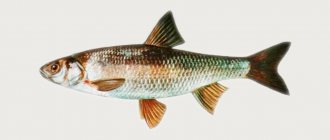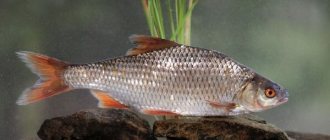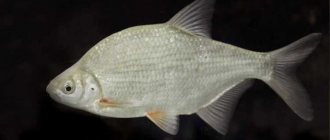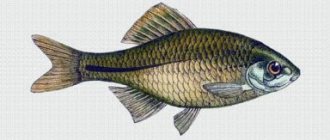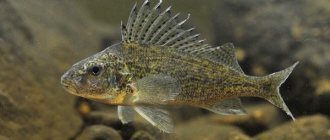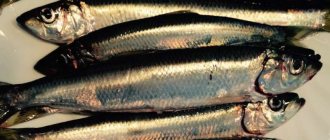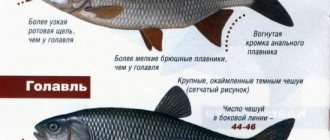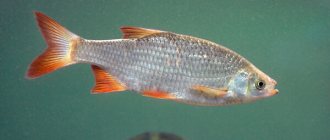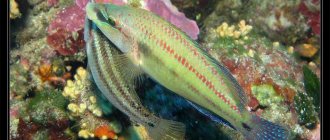Review author: “ZooVita”
Almost everyone knows what pike perch looks like. This fish has valuable tasty white meat, which is recommended to be included in the diet from childhood. In addition, there is no abundance of small bones in it. What gives fish great value is the absence of small bones, white, incredibly tasty, tender, dietary meat.
Look at the photo of the pike perch fish - its size inspires awe in any fisherman.
Appearance of pike perch
Pike-perch are bright representatives of the class of ray-finned fish and the Perch family. What does pike perch fish look like? The body of the fish is flattened from the sides, its body is elongated like that of a pike. The skin of the fish is covered with small dense scales. The upper part of the fish is usually gray-green; stripes consisting of brown spots stand out on the back. The belly is white-gray. There are 2 high sharp fins on the back of the fish.
The dorsal and caudal fins may have black spots. Other fins are yellow. The head is flat and elongated. Since pike perch is a predatory fish, the teeth on both jaws are sharp, fang-like.
Females have slightly smaller teeth than males. This predator is large in size; there are specimens over a meter long and weighing up to 20 kg. On average, the weight of each caught specimen ranges from 10-15 kg. The length of an adult is from 1 meter. Young individuals are up to 70 cm in size. The weight of the predator is from 2-3 kg.
What does pike perch fish look like?
The appearance of pike perch suggests that it is a carnivorous fish:
- An elongated, laterally flattened body and a flat, elongated head allow it to rapidly increase speed while jumping for prey.
- Pike perch has excellent vision and almost complete all-round visibility thanks to its rotating, bulging eyes.
- Small scales fit tightly to the body.
- The structure of the mouth allows it to capture large prey. Pike perch teeth have two pairs of fangs on the upper and lower jaws, which makes it possible to securely hold caught fish, frogs or river crustaceans.
- The body of the pike perch has a silver-brown tint with a greenish tint on the back. Dark transverse stripes are visible on the sides, the surface of the fins is covered with dark dots. This color makes pike perch almost invisible in thickets of coastal reeds, algae, and other natural shelters.
Where does pike perch live?
The habitat depends on what kind of fish the pike perch is. It belongs to schooling fish, but large individuals prefer a solitary lifestyle. Pike perch is a predator and has a wide habitat.
Is pike perch a sea or river fish? It lives mainly in clean, warm, fresh water, rich in oxygen, at a depth of 3-6 meters. Prefers a sandy or pebble bottom, with large sunken branches and stones.
Large populations live in freshwater bodies of Eastern Europe and Asia. It lives abundantly in the rivers of the Caspian, Azov, Black and Aral seas. This predator feels great in the desalinated areas of these seas. Lives in lakes Issyk-Kul and Balkhash.
Walleye are widely distributed in the United States and Canada. Walleyes may migrate, seeking out areas with cleaner water. Pike perch does not live in opaque water with suspended matter.
With good food, it can gain up to 1 kg of weight in a month.
Features and habitat
River pike perch is a very famous representative of perch fish. Distributed in Eastern Europe and Asia (fresh water bodies), in the river basins of the Baltic, Black, Azov, Aral and Caspian seas. It is caught in the waters of Lake Issyk-Kul and Lake Balkhash. This is a fairly large fish, growing over a meter in length. The weight of such individuals is 15 kg.
A characteristic feature is large fang-shaped teeth, between which there are small ones. Males have larger teeth than females. In the Caspian Sea and the Black Sea you can find the sea fish pike perch . These fish are smaller than their freshwater counterparts. Length is approximately 50-60 cm, weight – 2 kg. Pike perch is distinguished by a long, thin, laterally compressed body.
Pike perch toothy predator
From above, the head and back are gray-green, the belly is white. The scales are crossed with black stripes. The fin on the back and tail are decorated with dark spots, the anal fin is pale yellow.
Sea pike perch differs from freshwater pike perch not in size and habitat. They also have a smaller eye diameter and no scales on their cheeks. Pike perch have a very high sense of smell and can sense a huge range of odors. But this quality is never used by fish for hunting. Sea pike perch is protected by the state of Ukraine and is listed in its Red Book.
Being a valuable fishery object, there has been a significant decline in fish numbers. This happens due to the pollution of water bodies, but it is known that pike perch is a so-called water quality catalyst; it will never live even in dirty water.
As mentioned earlier, catch pike perch at any time of the year, but each season has its own characteristics. In all cases, it is necessary to study the habits, places where the fish live, and the food supply of the predator. Pike perch is a delicious fish, the meat of which, with full confidence, can be called a Russian fish delicacy. Lean meat can be fried, salted, smoked, boiled.
And the fish soup and aspic are very popular. Pike perch fish oil is unique; the meat contains a huge amount of vitamins and microelements that are necessary for health.
You can buy pike perch in almost any supermarket. However, fresh pike perch can spoil in a short period of time; when purchasing, you should pay attention not to the price, but to the production date indicated on the package.
Female and male pike perch
What does pike perch eat?
This fish is an ambush predator. It chooses shelter (stumps, snags, large stones) and waits for prey to swim past. The coloring allows the predator to be invisible against the background of the shelter. When the prey swims closer, the predator grabs it with a sharp movement.
Based on the structure of the oral apparatus (pike perch has a very narrow pharynx, its diet is narrow small fish (sprat, gobies, bleak, gudgeon, anchovy), crustaceans, and frogs.
The fry feed on invertebrate plankton (water mites, water donkeys, cyclops, crustaceans, daphnia). During daylight hours, the predator prefers to swim to deeper places; at night it comes out into shallow water. Often pike perch can be found in the same places where carp and bream live.
The zander has an excellent sense of smell. Having smelled a dead fish at the bottom, he does not disdain it.
Description of the species
Almost all perciformes prefer to hunt their own kind (roach, gudgeon, crucian carp, sabrefish, juvenile carp and bream) and do this with great passion, determination and patience. This can be either an active search for a victim or waiting for her for many hours in an ambush-shelter. And if, when looking at a perch, doubts may still arise whether it is a predator or not, then the appearance of the pike perch clearly indicates its carnivorous nature:
- an elongated flat head with several rows of sharp teeth;
- large, closely spaced fangs;
- elongated muscular body, laterally compressed;
- the line of the mouth shifted beyond the far border of the eyes for a wide opening of the jaws;
- 80-90 rows of small dense scales of the ctenoid type (with a prickly ridge of spines along the edges);
- anterior dorsal fin with hard rays;
- gill cover with sharp serrations.
To learn more:
Types of carp: mirror, koi and others
The fish is characterized by a camouflage color with vertical stripes, a light belly, and darker sides and back. The specific color scheme depends on the type and living conditions.
Volga pike perch or bursh
Volga pike perch or bersh - it has the smallest teeth of all species. The bursh has no fangs. The gills also have scales. Lives in the river basins of the Azov, Black and Caspian Seas, and is found in the Caspian Sea. It has commercial significance.
Common zander
The common pike perch is another species that is found in Russia. Its gills are free of scales, and its mouth has sharp fangs. The mouth is large, the upper jaw extends beyond the vertical of the posterior edge of the eye. Inhabits Lake Itkul in the Chalym River basin. Has no commercial significance.
Lightfin or yellow pike perch
Lightfin or yellow pike perch are found throughout the United States. It differs from the Common one mainly in its more elongated body and color. The fish is very large, but smaller than usual. Females are larger than males. Prefers to stay in small groups.
The eye has a light-sensitive element, thanks to which the fish sees well in muddy water, but avoids bright light. Lives mainly at greater depths than its European relatives.
What kind of fish is pike perch?
Appearance
Zander
- a predatory fish that lives in fresh water, from the Perch family. The body of the fish is elongated, on which there are two dorsal fins with hard rays and dark spots; the other fins are light yellow in color. The head has a pointed appearance, and the jaws have large fang-like teeth. It is this feature that distinguishes the fish from other predators.
The average parameters of pike perch are as follows: it grows up to 1 m in length and 15 kg in weight, 1 kg per year. The color of the fish is gray-green, the belly is silver-white, and there are up to 10 stripes on the sides.
Types of pike perch:
- ordinary,
- light gray
- sandy,
- nautical,
- Volzhsky
The species differ only in the size and color of the scales.
Reference: Pike perch meat contains approximately 20 amino acids, vitamins A, C, E, PP, group B, minerals: Mg, F, Fe, Cr, P, K, Ca, Zn, Mn, S and Cu. And in addition to all of the above, pike perch is a lot of easily digestible protein.
Walleye
Walleye are a small species of walleye. Body length up to 62 cm, weight up to 2 kg. It differs from the common pike perch in the diameter of the eye and fewer rays in the anal fin. There are dark spots on the second dorsal and caudal fins. It lives in the northwestern part of the Black Sea and the Caspian Sea. Listed in the Red Book of Ukraine.
The walleye or sand pike perch is the most commonly found freshwater fish in North America. They mainly lead a sedentary lifestyle.
During spawning periods they make long migrations. They live in both small and large rivers, reservoirs, and lakes. The body has a length of up to 76 cm. The usual length is 40 cm, weight up to 4 kilograms. Life expectancy is up to 18 years.
The color of this type of pike perch is darker, unlike other species. There is a dark spot at the base of the pectoral fin. There is no white spot on the bottom of the lower fins.
How much does pike perch fish cost, prices
The price per kilogram of pike perch fish differs depending on where it is sold. It's easier to compare offers from several stores.
Some novice fishermen, as well as buyers in a fish store, are interested in the question: is pike perch a bony fish or not? The question is quite appropriate, considering that river fish, as a rule, has more bones than sea fish. In this article we will talk about the bonyness and fat content of pike perch, processing features and popular methods of preparing it.
Reproduction of pike perch
Individuals of this predator reach sexual maturity by 5 years. When the water temperature rises above 10 degrees Celsius, the pike perch goes to spawn. Shallow water with thickets of aquatic plants and tree roots is suitable for spawning. Suitable for arranging nests and brushwood. There shouldn't be any current here. Fish avoid silted areas.
For 4 weeks, the female lays eggs at night in equipped nests. There can be up to 300 yellow eggs in a clutch. Caviar is sticky. Having completed her mission, the female swims away.
Guarding the egg clutch is the job of the males. It takes 2 weeks for the eggs to mature. The larvae hatch 7 days after incubation. Having reached a length of 3 cm, they actively begin to feed on plankton.
In the second year of life, the young already weigh 200 grams. After 4 years, the fry can reach 50 cm in height and weigh 4 kg.
Spawning
Puberty in this fish occurs closer to 5 years. Zander spawning begins early, when the water reaches a temperature of 8–10˚C. In the southern parts of the country it begins in the first week of April, in European regions - at the end of April, in the north of Russia - in the second ten days of May or early June. Natural populations of pike perch are found in large rivers of the Kama Basin, usually in the lower reaches, less often in the middle reaches.
For spawning, pike perch selects shallow areas of water with bushes. On average, spawning lasts 3 weeks, usually at night. One female produces about 200–300 thousand eggs of a light yellow color, 1–1.5 mm in size.
A mating pair of pike perch consists of a female and several males. The nest is formed by everyone together, but only one male mates, who guards the eggs until the young emerge.
Enemies of pike perch
The fry have many enemies: predatory fish species, and their own parents do not disdain them. Aquatic insects also do not ignore the larvae and fry of pike perch with their gastronomic attention. A large number of fry die from sudden changes in water temperature and storms. The eggs may dry out due to the sudden outflow of water from shallow waters.
One of the main enemies of pike perch is, of course, humans. Pike perch are caught in large quantities.
Methods and techniques for catching pike perch
Fishing methods:
- spinning, namely the jig method of catching and a retractable leash;
- Donka is not the most successful method, but when fishing at night with live bait, the hope of catching catfish or pike perch is extremely high;
- trolling is good for catching pike perch at high depths;
- vertical trolling on a balance beam is the best way for high-speed fishing in winter, as is the use of live bait.
Fishing technique
The technique for catching pike perch depends on many factors: location, water temperature, time of year, amount of food .
In the spring, fish are successfully caught using spinning rods and occasionally using a float rod with live bait. The pike perch is on the move, so you can throw it in different places in the reservoir.
In summer, all fish swim in the upper layers of water, especially in the morning and evening. The best way is spinning.
Autumn is considered the most successful time for catching pike perch on a spinning rod with any bait. You can also use donka with live bait. This type of serve is very effective at night, but a donka with a rubber shock absorber is recommended.
Amateur fishermen consider pike perch to be a stupid fish, but this is debatable, since the fish prefers clean waters with a lot of oxygen. They fish for pike perch using many methods and equipment, depending on the time of year and conditions.
